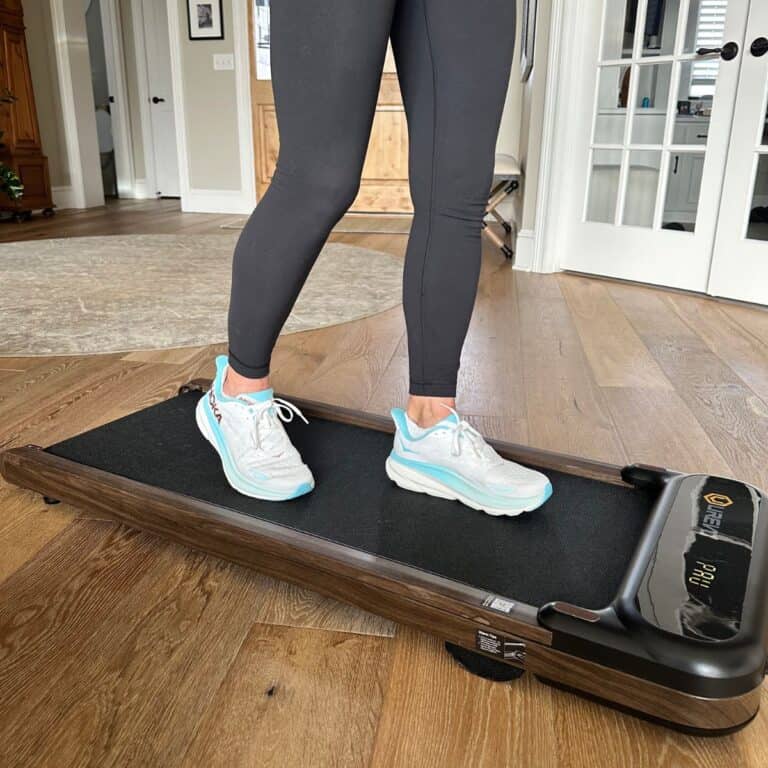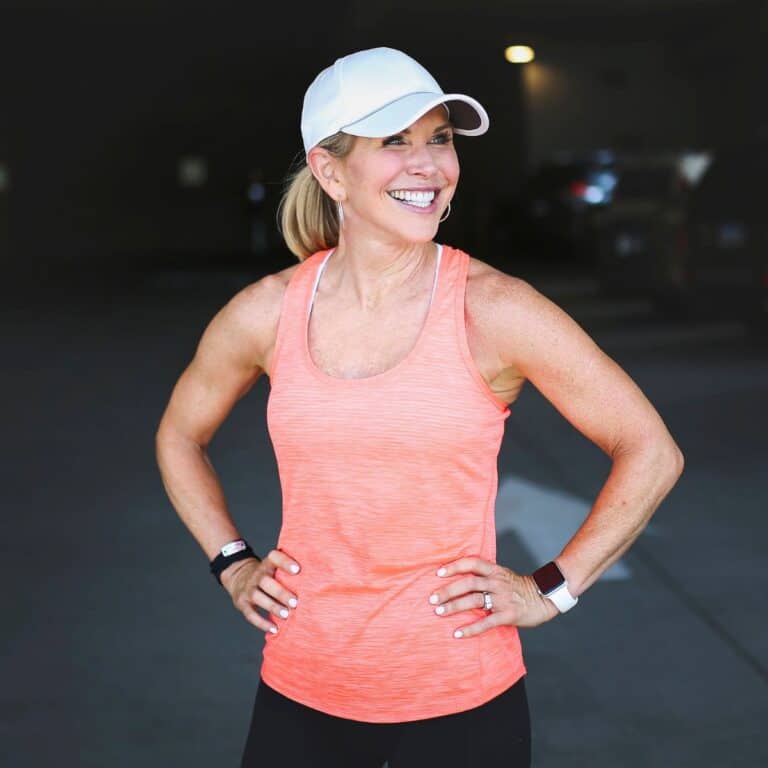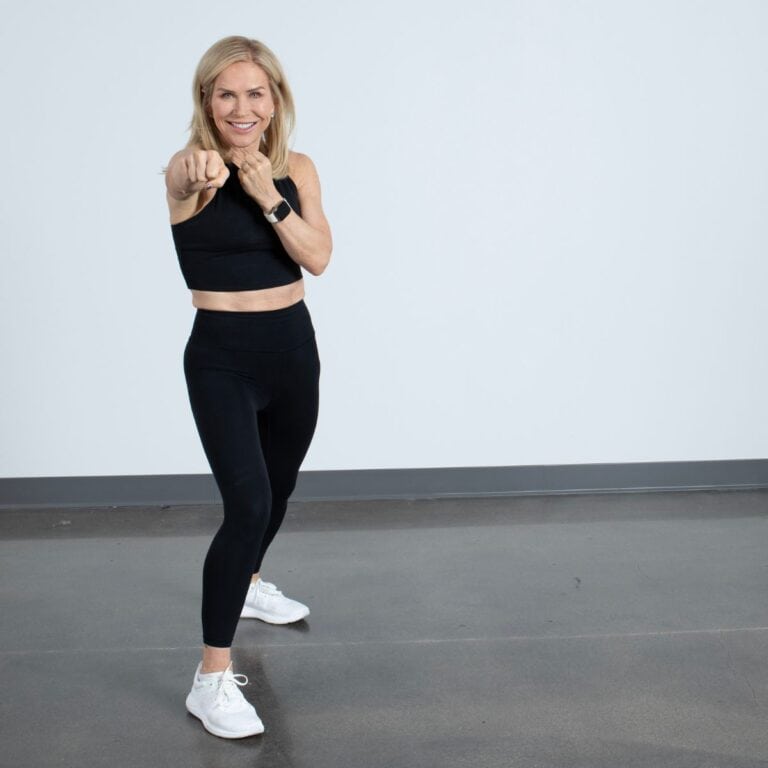I’m a 59-year-old personal trainer and health coach with over three decades of experience helping women navigate fitness through every stage of life. And let me tell you, I’ve been through it all—from marathon miles in my 30s to discovering the power of walking in my 50s.
These days, I proudly call myself a walker. Why? Because as I got older, running started to feel like a battle with my joints—especially my back and hips (yes, your spine has joints too!). But slowing down didn’t mean stopping. Instead, it meant shifting my approach and leaning into smarter, joint-friendly habits.
I get it—so many women tell me, “I’d love to work out, but my joints just can’t take it.” And believe me, I’ve been there! When I hit my 50s, those little aches and creaks became hard to ignore, and I knew it was time to prioritize self-care in a whole new way.
The good news? Staying active without pain is possible. With the right strategies, you can move more, hurt less, and keep doing what you love. In this post, I’ll share my favorite ways to protect your joints while exercising—simple, actionable tips that help me stay strong, mobile, and pain-free in my 50s and beyond.
Get the Latests Posts to Your Inbox
Join over 100,000 followers who are inspired to make healthier lifestyle choices as they age!
Let’s dive in—because taking care of your joints now means staying active for life.
Understanding the Causes of Joint Pain in Your 50s and Beyond
Let’s talk about why joint pain can sneak up on us in midlife. Trust me, I know how frustrating it is when your body starts to feel creakier than usual—especially when you’re trying to stay active! But understanding why it happens is the first step to keeping those joints happy and healthy.
Here’s what’s going on under the surface:
- Hormonal Shifts: Estrogen is like a natural joint protector—it helps reduce inflammation and keeps tissues strong. But as estrogen dips during menopause, many women start to feel more achy and stiff. It’s one reason why joint pain is such a common (and often surprising!) symptom in midlife.
- Wear and Tear on Cartilage: After decades of moving, squatting, and maybe a few missteps (hello, high heels and marathon training!), the cartilage that cushions your joints starts to thin out. Less cushion means more friction—causing stiffness, swelling, and those “ouch” moments when you move.
- Old Injuries Resurfacing: Ever had a sprained ankle or tweaked your knee years ago? Unfortunately, those past injuries can come back to haunt you. Scar tissue, imbalances, or untreated issues from your younger years can make certain joints more vulnerable to pain now.
- Inflammation and Arthritis: One of the most common culprits is osteoarthritis—a condition where the cartilage in your joints wears down, leading to pain and swelling. My brother is an orthopedic surgeon and he reminds me all the time, “You are 59 and so are your joints and bones. Every woman your age will show some degeneration and perhaps some arthritis. Don’t feel bad about it – do something about it.” And guess what? Inflammation from stress, poor diet, or lack of movement can also make it worse.
But Here’s the Best News:
You don’t have to stop moving! In fact, the right kind of exercise—paired with some smart self-care—can actually reduce joint pain. Motion is lotion (one of my favorite sayings!) and staying active is key to keeping your joints strong, flexible, and well-lubricated.
So, don’t let joint pain scare you off from your workouts. With a few mindful adjustments—which I’ll share next—you can stay active, feel better, and keep doing what you love for years to come.
My Top Tips for Preventing Joint Pain During Exercise
When it comes to staying active without joint pain, I always say—it’s not about doing less, it’s about moving smarter. I’ve learned firsthand that small adjustments can make a big difference. Here are my favorite strategies for protecting your joints while still getting those workouts in:
1. Warm Up Like You Mean It
I’ll be honest—when I was younger, I used to skip my warm-ups (big mistake!). But now? Non-negotiable! A proper warm-up gets your blood flowing, lubricates your joints, and prepares your muscles for movement. It’s truly your first line of defense against joint pain.
Try this quick 5-minute routine before every workout:
Dynamic Moves: Arm circles, leg swings, and torso twists to wake up your muscles.
Gentle Cardio: A brisk walk or some easy cycling to boost circulation.
Joint Mobility Drills: Roll those ankles, circle those wrists, and bend those knees.
2. Pick Joint-Friendly Workouts
You don’t have to ditch high-impact exercises forever—but it’s about balance. Mix things up with these low-impact options that are easy on your joints and effective for your body:
Walking: My personal favorite—especially on grass, trails, or a cushioned treadmill. Check out why I use my walking pad every day, in addition to my regular workouts!
Cycling: Great for your heart and legs, without pounding on your knees.
Swimming: Full-body, zero-impact goodness (and it feels amazing, too!).
Elliptical: A fantastic runner’s alternative with less strain on your joints.
And if you do love high-impact activities like running or HIIT, don’t worry! Just sprinkle in these low-impact workouts and always prioritize proper form.
3. Strength Train to Support Your Joints
Here’s the truth: Strong muscles = Happy joints. Why? Because muscles absorb shock and protect your joints from wear and tear. That’s why I’m in the weight room 3–4 times a week. My go-to moves include:
Bodyweight exercises: Squats, lunges, and push-ups (simple but effective!)
Resistance bands: Perfect for strength training without joint strain.
Dumbbells or light weights: Focus on controlled, slow movements over heavy lifts.
Quick tip: Form is everything! If you’re unsure, work with a trainer or follow my guided videos—because good technique keeps your joints safe.
Check out my favorite exercises that tone your arms without push ups.
4. Stretch and Stay Mobile—Every. Single. Day.
Tight muscles pull on your joints and cause pain—it’s that simple. So, I make flexibility and mobility training part of my daily routine. Here’s what works for me:
Daily stretching: Especially for my hips, hamstrings, and shoulders—my tight spots!
Yoga or Pilates: Great for flexibility and building joint-stabilizing muscles.
Foam rolling: I call this my DIY massage—it releases tension and keeps my joints happy.
Pro Tip: You actually need BOTH flexibility and mobility for a stronger healthier body!
5. Tune In to Your Body’s Signals
Pain is your body’s way of talking to you, so listen up! Here’s how I distinguish between the good and bad kinds of pain:
✔️ Good Pain: That post-workout muscle ache (hello, progress!).
❌ Bad Pain: Sharp, persistent, or stabbing discomfort—especially around joints.
If your joints feel off, modify, rest, or ice the area—and if it keeps up, see a pro. Your body’s voice matters—honor it.
6. Cool Down—Because Recovery Counts
You warmed up—now finish strong with a proper cool-down. It prevents stiffness and keeps your joints mobile. I alwaysend my workouts with:
Gentle stretching: Hold each stretch for 20–30 seconds.
Deep breathing: It calms your body and helps you recover faster.
A short walk: Gradually brings your heart rate down.
7. Eat and Drink for Joint Health
Healthy joints start from the inside out—so what’s on your plate (and in your water bottle) matters. Here’s how I fuel my body to keep my joints strong and pain-free:
Anti-inflammatory foods: Salmon, berries, nuts, and leafy greens are my staples.
Hydration: Your joints need lubrication! I aim for at least 8 glasses of water a day.
Supplements: I personally include collagen and omega-3s to support my joints—but always check with your doctor first!
8. Infrared Light Therapy (Yes, Every Day!)
Infrared light therapy has become part of my daily wellness routine. It helps reduce inflammation, relieve stiffness, and promote healing—like giving my joints a little love before they start complaining. I have a flex pad that I usually put on my back. But it bends to go over the hips and/or joints.
9. Don’t Overlook Hormone Health
For me, managing joint pain in midlife also meant addressing my hormones. Estrogen plays a huge role in joint health (who knew?!), so after careful research and discussions with my doctor, I chose to incorporate Hormone Replacement Therapy (HRT). It’s been a game changer in reducing inflammation and keeping my joints (and the rest of me!) feeling strong. For more information, check out the book The New Menopause.
Bottom Line:
You can prevent joint pain and stay active in your 50s and beyond—it just takes the right tools and a little TLC. And guess what? You don’t have to go it alone! I’ve got tons of free videos to help you with mobility, stretching, strength, and low-impact cardio—so no excuses! 😉


